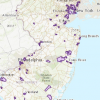Tax Policies
New Jersey’s fragmented system of local governance and its disproportionate reliance on property taxes for funding local services (particularly schools) combine to create incentives that have powerful, distorting effects on land-use decision-making.
Because municipalities are so often on their own to pay for local schools (regional, multi-municipality K-12 school districts are the exception, not the rule), every municipality has an incentive to adopt zoning that discourages any residential development that might attract new schoolchildren and hence require a hike in property tax rates. Instead, municipalities compete for the limited number of “clean ratables,” such as distribution warehouses, that their region can sustain. This results in the sub-optimal location of these major projects and additional tax pressure on residents of those municipalities that are unable to score them.

Municipalities face a tricky balancing act when it comes to infrastructure improvements: they need to address large, costly projects but have limited resources to fund them. Historically, issuing debt has been the primary means that municipalities are left with to finance critical improvements. However, municipal leaders are reluctant to be the ones responsible for issuing debt, while utilities and public systems are often hesitant to raise rates to cover project costs.

New Jersey’s proposal to designate 169 Census tracts as Opportunity Zones has been approved. Analysis shows they represent the kinds of places where the state would like to direct growth, and where targeted investment can catalyze economic revitalization.

At New Jersey Future’s Redevelopment Forum, expert in redevelopment finance discussed opportunities presented by a variety of new and existing financing tools, and emphasized that changes in Washington and Trenton are likely to bring more complexity to the field.

Smart-growth policy issues are well represented by the 15 experts now or formerly associated with New Jersey Future who have been named to the transition teams working with Governor-elect Phil Murphy.
We asked the Democrat and Republican candidates for governor how they would approach some of the key issues the winner will face when he or she takes office. Here is what they said.

The Economic Opportunity Act of 2013 included additional incentives for projects destined for “smart-growth” areas. This report analyzes how effective the updated incentives have been at directing growth to those areas. December 2014.

New Jersey has 243 transit facilities, ranging from small single-track stations to major multi-line hubs. The unique characteristics of each station, of its immediate neighborhood, and of its surrounding municipality mean that a wide variety of development strategies should be brought to bear in order to maximize each location’s potential. This report shows how data assembled by New Jersey Future can be used to make decisions on how to target various kinds of transit-oriented development efforts. September 2012.

Some frequently-asked questions about how smart growth would affect New Jersey’s future development, including how it affects traffic, taxes, and land preservation.
Research that examines whether the popular belief is true that municipalities with the highest concentrations of commercial properties also tend to have the lowest residential property tax rates. July 2010.

An examination of the problems caused by recent development patterns in New Jersey, and recommended steps to address them through smart-growth principles. April 2001.
See all New Jersey Future Blog posts and articles in this category »
Reports, Presentations and Testimony
- 02/11/2019: Testimony on Economic Development Incentives
- New-Jersey-Future-Assessment-of-the-NJLIHTC-program
- New Jersey Future 2017 Gubernatorial Platform
- Economic-Opportunity-Act-and-Smart-Growth-Progress-Report
- Targeting Transit -- New Jersey Future
- Financial Benefits of Density in Two New Jersey Downtowns 7-11 (Intern report)
- Presentation: Reining In Local Budgets 05-10
- Chasing Their Tails: Municipal Ratables Chase Doesn't Necessarily Pay 07-10
- Realistic Opportunity? The Distribution of Affordable Housing and Jobs in New Jersey











